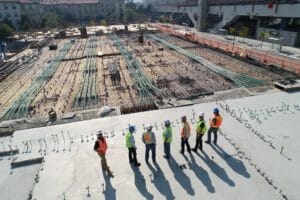Understanding where wetlands are present and what characterizes them is challenging. An area may appear wetland-like, but that doesn’t necessarily mean it is one.
That’s where this article can help. We explore the different types of wetlands and the criteria professionals use to identify and classify them. Then, we talk about the role of wetlands in environmental conservation and future challenges in the realm of wetlands delineation.
Understanding Wetlands
Wetlands are areas of land covered by shallow water or soil that remain saturated for most of the year. Various types of wetlands exist, including:
- Swamps –Wetlands associated with rivers and streams in the Mid-Atlantic and Southeastern regions of the U.S. (i.e., Virginia, Maryland, North Carolina, Georgia, Florida, etc.)
- Marshes – Areas of herbaceous vegetation, including bulrushes and cattails
- Bogs – Wet areas dominated by various moss species that build up in thick, peaty layers
The Elements of Wetlands Identification
To classify an area of land as a wetland, all three of the following elements must be present:
Vegetation
The type of vegetation can indicate the presence of wetlands. Wetland areas usually have a dry growing season, but experience waterlogged soil or have standing water the rest of the year. During these periods, wetland-specific species printed in the National List of Plant Species that Occur in Wetlands by the U.S. Fish and Wildlife Service grow abundantly. The Wetlands Identification process requires consulting this database and comparing it to the plants growing on-site.
Wetland vegetation also differs in character from those growing in non-wetland areas. Trees and plants located in wetlands often have shallow roots and swollen trunks to adapt to wet conditions.
Soil
Soils in wetlands also differ from those in non-wetland areas. The environment makes them waterlogged and oxygen-deprived, preventing normal plant decomposition. Organic matter can accumulate on the soil surface in the form of peat or muck, making soil grayish and sometimes producing an odor like rotten eggs.
Hydrology
Finally, wetland soils have a specific “hydrology,” where they harbor surface water for long stretches of the year. Testing this requires gaging stations or groundwater wells.
When, and only when, a land area has the vegetative, soil, and hydrological elements consistent with a wetland will it be considered a wetland by a jurisdiction.
Importance in Environmental Conservation
Wetlands play an essential role in environmental conservation. These unique habitats play host to diverse ecosystems that support the surrounding ecology. Therefore, wetlands identification and delineation are necessary for proper environmental management.
Benefits of caring for these areas include:
- Increased biodiversity. Wetland ecosystems are havens for wildlife species, including birds, fish, snakes, turtles, frogs, bugs, and salamanders. These species also support additional species, including squirrels, deer, and bears. For instance, in North Carolina, over 70% of the state’s endangered species depend on wetlands to survive.
- Better flood control. Wetland areas act as natural sponges, helping to delay the interval between storm peak and flood peak. Areas regulate water flow, preventing the rapid swelling of rivers and streams.
- Improved water quality. Incredibly, wetlands can also enhance water quality. Natural sandy sediments filter pollutants, preventing them from accumulating in streams, rivers, and lakes.
- Enhanced habitat preservation. Finally, wetland conservation helps to preserve natural habitats supporting the above species.
Challenges and Future Directions
While criteria for wetland identification and delineation exist, there are various challenges associated with it. These areas are often hard to define.
One common problem is data limitation. For instance, automated techniques like Shuttle Radar Topography Mission (SRTM) data can mistakenly identify streams and rivers or find it hard to delineate non-smooth boundaries.
Human subjectivity can also hamper efforts. Traditional field methods often rely on expert judgment, which can cause inconsistencies between experts and technicians. Professionals may disagree.
Land use changes may also play a role. When society drains wetland landscapes, remote sensing technologies are less accurate and more prone to generating invalid results. Human activities change areas, giving them a different character that sensing methods can’t accommodate.
Even climate change can make identification and delineation more challenging. Rain pattern variation may mean that areas that used to be wetlands are now much drier.
Fortunately, advancements and emerging technologies are helping to resolve these issues. New systems are improving data and making characterization more straightforward.
For example, LiDAR is helping technicians more reliably assess landscapes’ microtopography. Drones and UAVs assist this technology, providing professionals with high-definition imagery to complement topological findings.
Machine learning and AI are also playing a role. Pattern-recognizing software can increase confidence in findings by comparing data to known characteristics of wetland environments. Combining various sources boosts the precision of results and reduces the risk of false positives and negatives.
Get Help With Environmental Compliance
DFM offers a comprehensive environmental compliance consulting service to assist anyone developing near wetland areas. Talk to our team today to discuss how we could help you identify wetlands and delineate their boundaries reliably and accurately.




